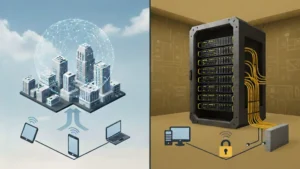Subscription vs. License-Based ERP: Which Is Better for Long-Term Growth?
In today’s fast-evolving digital economy, Enterprise Resource Planning (ERP) systems are the backbone of business operations — integrating finance, supply chain, manufacturing, sales, and human resources into one unified platform. But when it comes to adopting an ERP, one question keeps business leaders and IT managers debating: Should you choose a subscription-based (cloud) ERP or a license-based (on-premises) ERP? This question isn’t just about pricing models; it’s about long-term scalability, innovation, and total cost of ownership (TCO). As more businesses move toward cloud-based solutions like Microsoft Dynamics 365, it’s important to understand what each model offers — and which one aligns best with your growth strategy. In this article, we’ll explore the key differences between subscription and license-based ERP models, their advantages and drawbacks, the financial and operational impacts, and how to choose the right option for long-term success. Understanding ERP Deployment and Licensing Models Before diving into comparisons, let’s clarify what these two models mean in practice. 1. License-Based ERP (Perpetual License) A license-based ERP involves purchasing a software license outright, which gives your company the right to use the software indefinitely. Traditionally, this model is paired with on-premises deployment, where the software is installed on your own servers, and your internal IT team (or a partner) manages the infrastructure, upgrades, and security. Key Characteristics: Examples: Microsoft Dynamics AX, SAP ECC, Oracle E-Business Suite (legacy editions) 2. Subscription-Based ERP A subscription-based ERP operates under a pay-as-you-go model. You pay a recurring monthly or annual fee to access the software, which is typically hosted in the cloud by the vendor or a managed partner. Key Characteristics: Examples: Microsoft Dynamics 365 Business Central, Oracle NetSuite, SAP S/4HANA Cloud Key Differences Between Subscription and License-Based ERP Factor Subscription-Based ERP (SaaS) License-Based ERP (Perpetual) Cost Structure Monthly/annual OPEX One-time CAPEX + maintenance Deployment Cloud-hosted On-premises or private cloud Scalability Easily scalable up or down Limited by hardware and licenses Upgrades Automatic, frequent updates Manual upgrades; costly & disruptive Security & Compliance Managed by vendor (enterprise-grade) Managed internally Customization Limited but configurable Deep customization possible Integration with Modern Tools Native integration with cloud apps, AI, Power BI May require manual integrations Access & Mobility Accessible anywhere, anytime Typically on-premises access TCO (Total Cost of Ownership) Lower over time for SMBs and mid-market Potentially lower for large enterprises over 10+ years Deep Dive: Advantages and Drawbacks of Each Model Subscription-Based ERP – The Modern Approach Advantages: Drawbacks: License-Based ERP – The Traditional Powerhouse Advantages: Drawbacks: Total Cost of Ownership (TCO) Comparison When evaluating ERP options, cost must be viewed beyond licensing alone. Here’s how both models typically compare across time: Cost Element Subscription ERP (Cloud) License ERP (On-Premises) License Monthly/annual subscription One-time perpetual license Infrastructure Included in subscription Requires servers, network, backup Maintenance Included Annual support fee (15–25%) Upgrades Included automatically Paid upgrades (every 5–7 years) IT Staff Minimal Dedicated internal team required Security Managed by vendor Managed in-house Scalability On-demand Hardware-dependent Long-Term Cost (10 yrs) Potentially higher for very large users Potentially lower after break-even point Insight:For small and mid-sized businesses (SMBs), subscription ERP typically offers lower TCO and higher agility. For large enterprises with established IT infrastructure and predictable operations, license-based ERP may eventually become more cost-efficient — provided they manage it effectively. The Future is Cloud – Here’s Why Over the past decade, the ERP landscape has undergone a massive transformation. According to industry reports, more than 80% of new ERP implementations today are cloud-based. Microsoft, SAP, and Oracle are all transitioning customers from their legacy on-premises products to modern SaaS platforms. Here’s why cloud subscription models are dominating: Which Model Is Right for You? The decision depends on your size, industry, IT maturity, budget, and growth objectives. Here’s a practical framework: Choose Subscription-Based ERP (Cloud) Choose License-Based ERP (On-Premises) : Hybrid ERP: The Best of Both Worlds Many companies are now adopting hybrid ERP models, combining the stability of on-premises systems with the flexibility of cloud applications. For instance, a manufacturer may run core financials and operations in Dynamics 365 Finance (cloud) while maintaining on-premises systems for shop-floor control or legacy integrations. The hybrid model provides a balanced approach to innovation and control. Benefits of Hybrid ERP: Drawbacks: Nevertheless, hybrid ERP serves as a strategic bridge for organizations transitioning from legacy systems toward full digital transformation. Microsoft Dynamics 365: A Real-World Example Microsoft Dynamics 365 offers flexible licensing options — subscription-based SaaS as the default model and on-premises deployment for specific industries and compliance needs. Why it stands out: For businesses aiming for long-term growth, Dynamics 365’s cloud-first model enables agility, innovation, and scalability while maintaining enterprise-grade security and compliance. The Strategic View: Long-Term Growth Implications When evaluating ERP models for long-term growth, think beyond immediate costs — focus on strategic flexibility, innovation velocity, and business resilience. Growth Factor Subscription (Cloud) License (On-Prem) Innovation Continuous delivery, AI-first Limited upgrades Scalability Dynamic scaling Hardware-dependent Agility Rapid deployment & updates Slow change cycles Cost Control Predictable, flexible High upfront, low variable Security Vendor-managed enterprise-grade Internal responsibility Long-Term ROI High for fast-growing firms High for stable enterprises Future Readiness Built for digital transformation May require modernization later In essence, subscription-based ERP is the better choice for most growing organizations. It offers agility, lower barriers to entry, and constant innovation — all essential in an economy defined by rapid technological change. License-based ERP still has relevance for specific industries and large enterprises needing full control, but even these organizations are gradually adopting hybrid or cloud-first strategies. Conclusion Both subscription-based and license-based ERP models have their place in today’s business landscape. However, when it comes to long-term growth, the balance increasingly tilts toward the subscription (cloud) model. Subscription ERP: License ERP: For most businesses aiming to future-proof their operations, cloud ERP platforms like Microsoft Dynamics 365 represent the smarter, more sustainable path forward. As the world continues to shift toward AI-driven, data-centric operations, flexibility and continuous innovation will define success — and subscription-based ERP models are designed precisely for that. Frequently Asked Questions (FAQs) Q
Subscription vs. License-Based ERP: Which Is Better for Long-Term Growth? Read More »




